 |
PERCEPTION I:Max Wertheimer, Figure and Ground, Law of Closure |
| << HEARING (AUDITION) AND BALANCE:The Outer Ear, Auditory Canal |
| PERCEPTION II:Depth Perception, Relative Height, Linear Perspective >> |
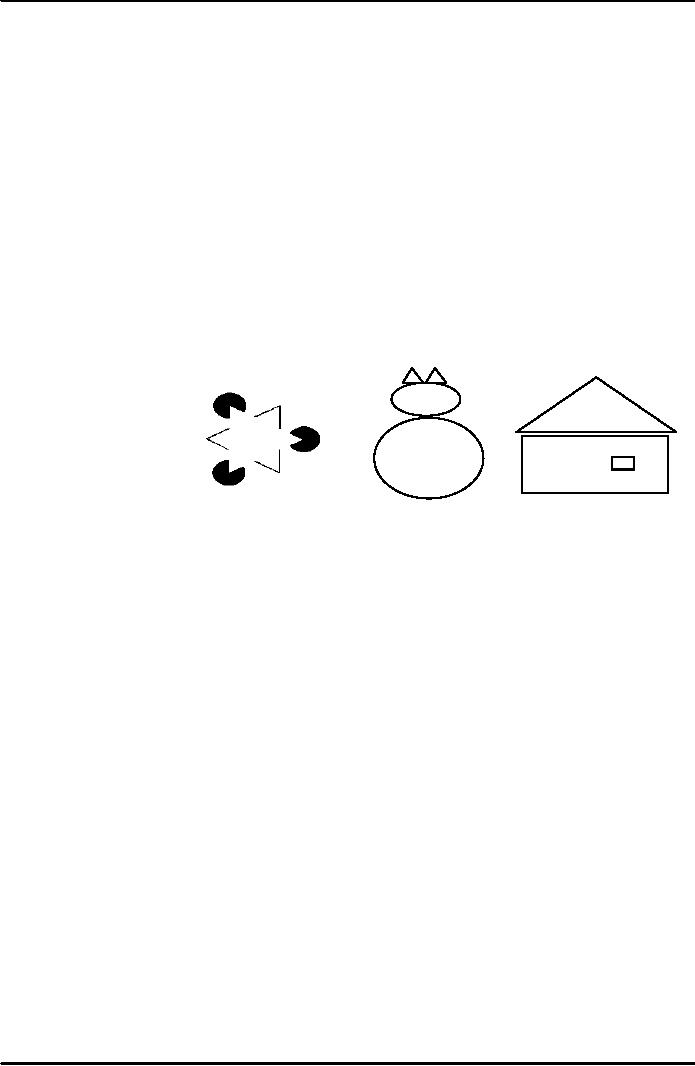
Introduction
to Psychology PSY101
VU
Lesson
17
PERCEPTION
I
"Perception
is not determined simply by stimulus
patterns; rather it is a dynamic
searching for the
best
interpretation
of the available data."
Gregory
(1966)
The
process of selecting, organizing, and
interpreting stimuli; it includes
identification,
recognition,
and images of the stimulus in question;
previous experiences have a
role to play in
it.
Perception
is holistic. Perception is the mental organization and
interpretation of sensory information.
The
Gestalt
psychologists studied extensively the
ways in which people organize and
select from the vast
array
of
stimuli that are presented
to them, concentrating particularly on visual stimuli.
Perception is influenced
by
a variety of factors, including the intensity
and physical dimensions of the
stimulus e.g. such
activities of
the
sense organs as effects of
preceding stimulation; the subject's past
experience; attention factors
such as
readiness
to respond to a stimulus; and
motivation and emotional
state of the subject. Stimulus
elements in
visual
organization form perceived patterns
according to their nearness to
each other, their
similarity, the
tendency
for the subject to perceive
complete figures, and the
ability of the subject to distinguish
important
figures
from background.
If
you look at the following
figures you may see
two overlapping triangles, a
cat, and a hut. Why don't
we
see
them as different separate triangles,
ovals, and
rectangles???
Different
Connotations of the Word
`Perception
oProcess,
act, or faculty of perceiving.
oEffect
or product of perceiving.
oRepresents
what is being perceived.
oAwareness
of something with the help of
sense organs/ sensations.
oFeelings,
attitudes, opinions, and
images people possess about
different places, people, and
environment
of
various kinds.
oImmediate
or
intuitive cognition or comprehension__
capacity to "analyze"/ "see"
with the help of
experience.
oThe
ability to process or use
information coming/ received
from the senses
oProcess
of classifying sensations.
A
Comprehensive Definition of Perception
would
be that of a cognitive process
involving:
�
Acquisition,
�
Interpretation,
�
Selection,
and
�
Organization of
sensory information,
that
involves past experiences as
well as neurological processes that
affect recognition and
interpretation.
Gestalt
Psychology
The
Gestaltists made an important
and lasting contribution to
our understanding of perceptual
processes.
They
did show that certain,
explicit, factors do affect the way in
which incoming stimuli are
organized into
figures.
�
It developed
as a reaction to structuralism in the early
1900s.
103
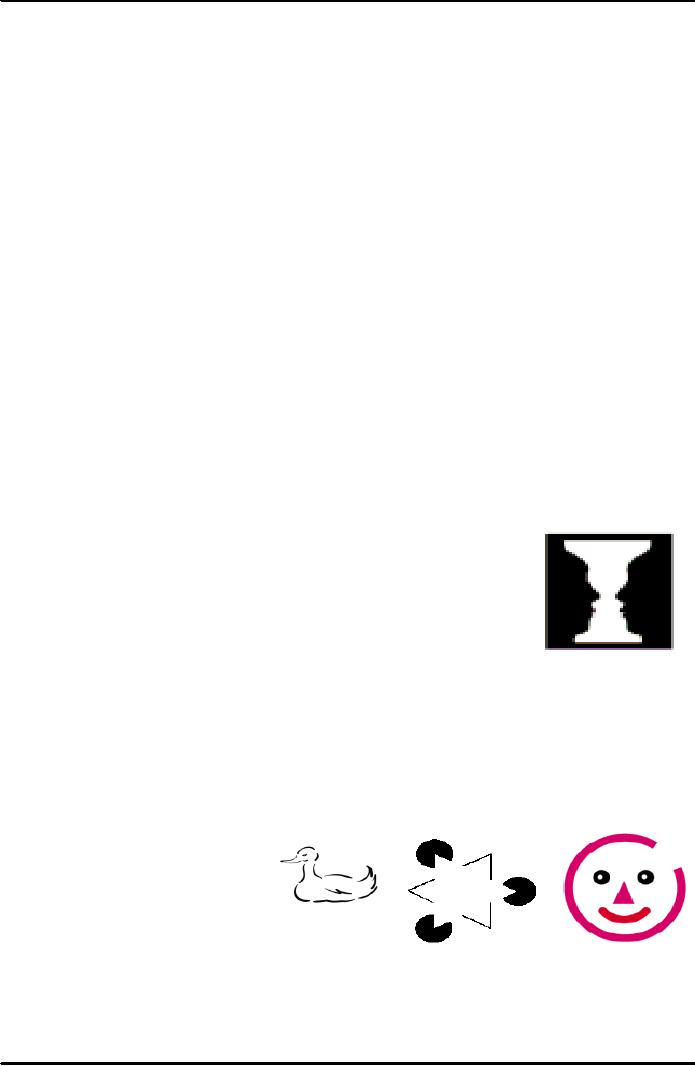
Introduction
to Psychology PSY101
VU
�
In
contrast to the structuralist approach of
breaking down conscious experience
into elements, or
focusing
upon the structure of mind, the Gestalt
school emphasized the significance of
studying
any
phenomenon in its overall
form.
�
Gestalt
means "Configuration".
�
Gestalt
psychology emphasized that the
"WHOLE"
is
more than the sum of its
parts, and it is
different
from it too.
�
Concentrated
on how people consider individual
elements together as units or
wholes.
�
The
concept of Gestalt applies to everything,
objects, ideas, thinking
processes and human
relationships.
�
Any
phenomenon in its entirety may be
much greater than when seen
in a disintegrated form.
Max
Wertheimer
�
The
founder of Gestalt psychology; Kurt
Koffka and Wolfgang Kohler
followed Wertheimer.
�
Wertheimer
became aware of a form of
apparent motion that was
called "phi
phenomenon".
Phi
phenomenon = when
two lights are in close
proximity to each other, flashing
alternately, appear to be
one
light moving back and
forth; therefore the whole was
different from the separate
parts.
�
Movement
is perceived whereas it never
occurred.
�
Explanation
of phi phenomenon led to a separate
school of thought that had
deep rooted impact
on
learning, ethics, and social
psychology.
�
We
perceive experiences in a way
that calls for the simplest
explanation, even though reality may
be
entirely
different. We tend to organize
our experience so that it is as
simple as possible. = Gestalt
Law
of Minimum Principle.
�
Gestalt
Psychology maintained that the main
task of psychology is to explain
attitudes, events,
behaviors
etc as `complete' or `whole'__ not in
terms of elements or disintegrated
parts; the overall
impact
is what makes perception.
Figure
and Ground
�
How
do we perceive a figure against a
background?
�
Certain
processes are involved in distinguishing
a certain figure or
object
from a ground.
�
We
do not just passively receive what is
reflected on to our
retinas;
we
try to give a meaning to what we see,
and therefore `understand'
our
sensations
Gestalt
Laws of Perceptual
Organization
Organizing
raw sensory stimuli into
meaningful experiences involve
"cognition", a set of
mental
activities
that includes thinking,
knowing, and remembering. Knowledge and
experiences are
extremely
important for perception,
because they help us make
sense of the input to our
sensory
systems.
�
We
organize our experiences
according to certain rules, in a
simple way:
I.
The Law of Closure.
II.
The Law of Proximity.
III.
The Law of Continuity.
IV.
The Law of Similarity.
V.
The Law of Simplicity.
VI.
The Law of Common Fate.
VII.
The Law of Enclosure/
Connectivity.
I.
Law of Closure
The
perceptual tendency to fill in the
gaps and complete the
contours; perceiving the disconnected
parts as
the
whole object. We mentally close the gaps
and perceive the figure given below as
wholes.
104
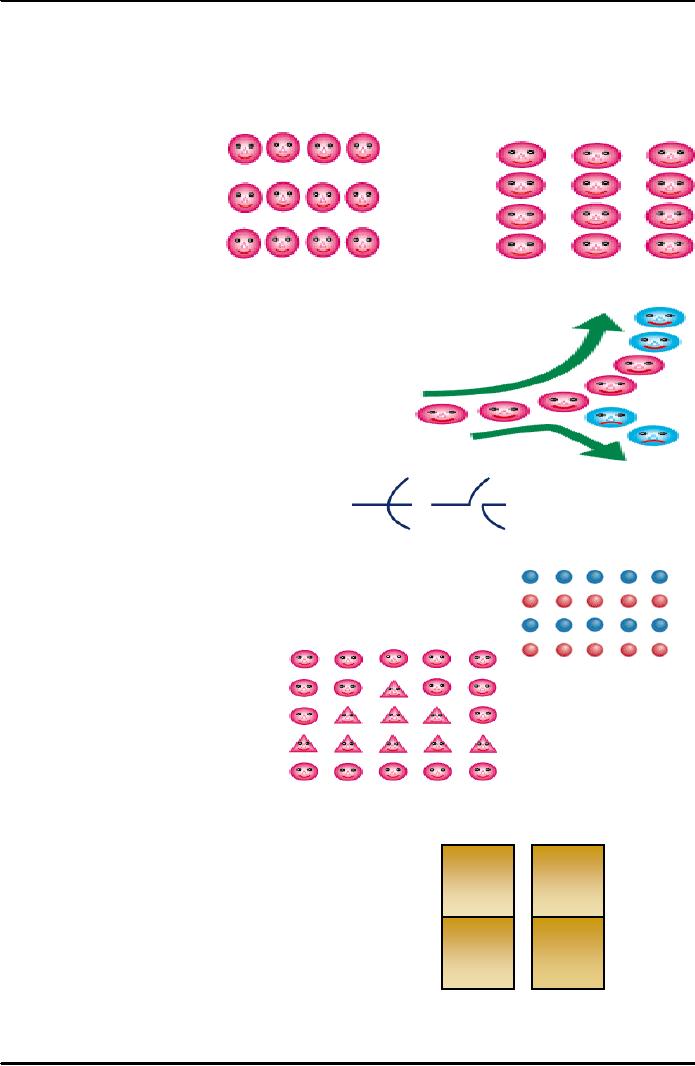
Introduction
to Psychology PSY101
VU
This
tendency enables us to perceive
whole objects from incomplete
and imperfect forms
II.
Law of Proximity
We
have the perceptual tendency to
group together the auditory and
visual events that are
close or near one
another;
they are perceived as a coherent object.
In the figures below, we see that on the
left, there appears
to
be three horizontal rows,
versus three columns on the
right.
III.
Law of Continuity/
Good
Continuation
We
tend to group the
stimuli
into
smooth and continuous
patterns
or parts. Humans have a capability to
continue contours whenever the elements of the
pattern
establish
an implied direction.
In
the drawing below, we see a curved
line with a straight
line
running
through it. In the other, we do
not see the drawing as
consisting
of the two segments and
perceive it as a continuous
pattern.
IV.
Law of Similarity
The
tendency to perceive objects,
patterns or
stimuli
which are similar in
appearance as a
group;
parts of the visual field
that are similar in
color,
light, texture, shape, or any
other quality
are
seen as one.
Elements
that appear similar will be
perceived as part of the same
form/
sequence;
there seems to be a triangle in the
circles and the smaller
triangles
are
perceived as one group.
V.
Law of
Simplicity/ Law
of
Pr�gnanz
People
intuitively prefer the simplest,
most
stable, straightforward, and
basic
form
of possible organizations.
A
stimulus
is
organized into as good and
simple a form as possible; `good'
refers to
symmetrical,
simple, and regular.
In
the following figure you
tend to see
four
squares rather than ends of
logs of
wood
or biscuit packs.
105
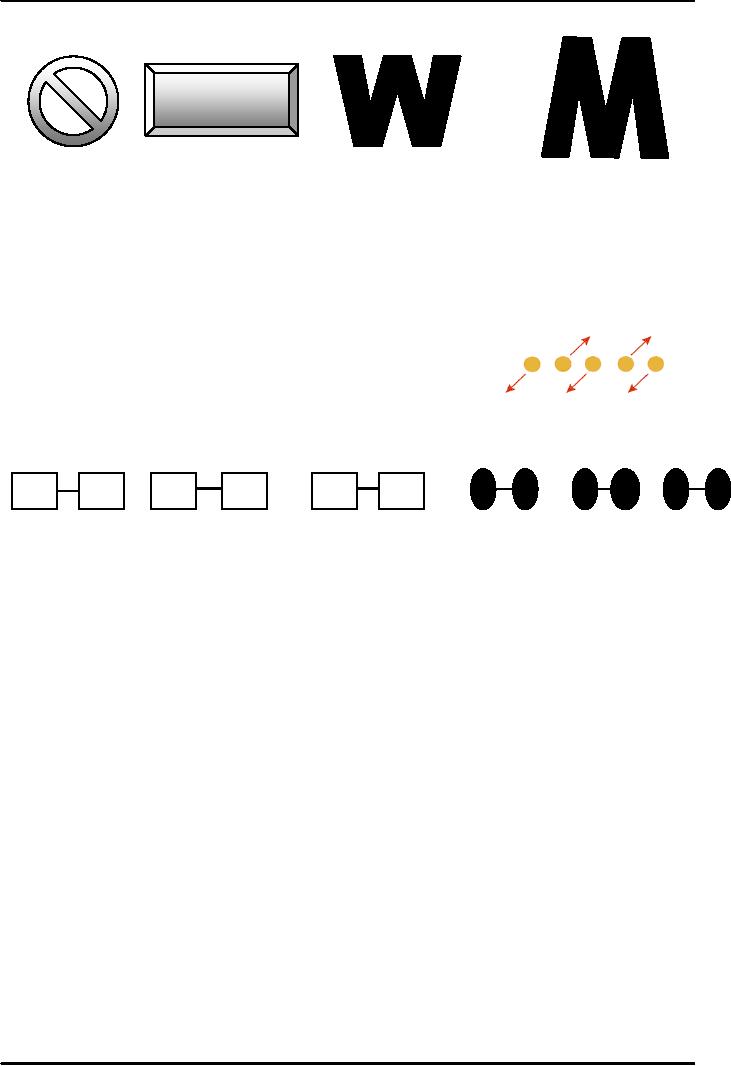
Introduction
to Psychology PSY101
VU
In
this one you tend to see two
separate shapes rather than
different separate parts
joined together.
In
the figure on the right you see a diamond
inside black lines and
not as an `M' under a `W',
which actually
is
the case.
VI.
Law of Common Fate
It
is the tendency to group together the
objects that move together, or seem to
move together, and in the
same
direction.
When
they are being seen in actual
motion, humans' will mentally
group them as moving in
the
same direction. Because of this we
often see flocks of birds or herds of
cattle, or boys or girls
playing
together
as one group
VII.
Law of Enclosure/ Connectivity
It
is our perceptual tendency to
perceive features/ patterns,
such as dots
or
objects as a single unit
when uniform and linke;
lines, dots, areas,
objects
etc are perceived as single
or same unit when combined or
linked.
Feature
Analysis
�
The
process of perceiving a shape, pattern, object, or
scene by attending to the individual
elements
making
it up.
�
The
Gestaltist emphasis was upon the
way we interpret the individual
elements as a pattern/
sequence
which has some sort of
meaning; The organized or
well formed sequence gives a
different
percept
or meaning as compared to when separate
parts or elements are
observed.
�
The
approach of feature analysis looks
into the individual components in
order to understand the
entire
nature of what we perceive.
�
The
feature analysis starts with
the activation of the neurons in the brain, as they
are sensitive to
particular
spatial configurations such as circles,
angles, edges, curves etc.
Since these neurons
are
individually
present, it is taken to be the evidence
of the idea that any pattern,
sequence or
component
can be broken down into
simpler events or parts e.g.
the letter "P" is the
combination
of
a vertical line, and a semi- circle; or
an "X" is a combination of a "v' on an
inverted "V".
�
150
million objects can be produced
out of just 36 fundamental
components.
In
summary
�
Stimuli
are first broken down
into their component parts;
these parts are then
compared to data
stored
in our memory in order to
find a match; the stimulus is
identified and recognized
once a
match
is found.
�
The
feature analysis starts with
the activation of the neurons in the brain, as they
are sensitive to
particular
spatial configurations such as circles,
angles, edges, curves etc.
Since these neurons
are
individually
present, it is taken to be the evidence
of the idea that any pattern,
sequence or
component
can be broken down into
simpler events or parts e.g.
the letter "P" is the
combination
of
a vertical line, and a semi- circle; or
an "X" is a combination of a "v' on an
inverted "V".
�
150
million objects can be produced
out of just 36 fundamental
components.
�
The
figure below shows the
process of how we perceive a
`B' as a `B'.
106
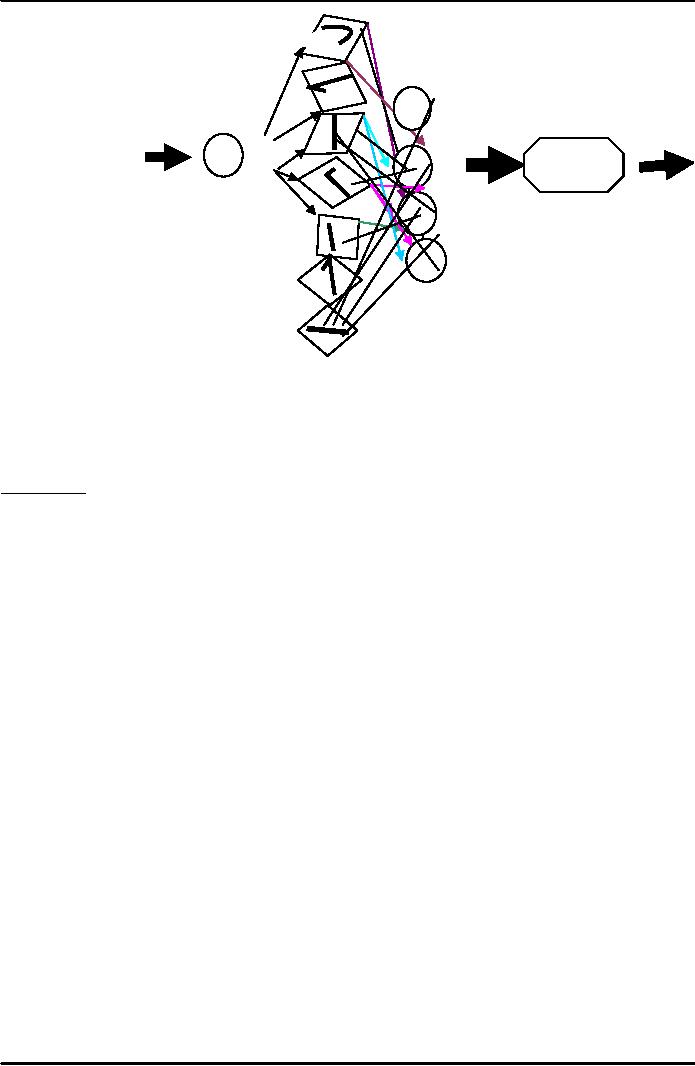
Introduction
to Psychology PSY101
VU
T
B
Decision
B
B
E
P
R
Steps
in Feature Analysis
a.
Identify the feature, shape of
any object, of which the image
falls on the retina.
b.
Combine/ gather object in some
form/pattern so that some
sort of
representation
can be formed.
c.
In the final stage, we identify/
compare each component/element/ object
with
the
help of past experiences or
memories.
Top-
Down and Bottom- Up
Processing
`Top-
Down' processing refers to the
perceptual phenomenon guided/ and
influenced by;
oKnowledge,
oExperience,
oMotivation
and
oExpectation
A-e-
yo- g-o - ng t- sc--l?
Top-
down processing is guided by the higher
mental/ knowledge faculty such as meaning
of the sentence
of
which the important letters
are missing__ individuals
are able to understand the
meaning of the sentence
and
fill in the gaps by using
their prior experiences and
memories.
Bottom-
Up processing refers to
the
Process
of recognizing and processing of
information about the individual
component/ part of the
stimulus.
Humans
will be unable to identify the object
component unless they are able to
recognize and
understand
the shape and features of
each element that makes it
up; in the sentence "A-e- yo- g-o -
ng
t-
sc--l?" you will not be
able to identify the sentence
unless you recognize the
individual shapes
making
up the overall form of the
letters.
Top-
down and bottom- up
processing occur simultaneously
and have an interaction with
each other,
which
makes it possible to understand the
complex perceptual phenomena.
The
process of perception involves the
environmental stimuli, which is interpreted,
analyzed and
integrated
with the help of past
experiences.
107
Table of Contents:
- WHAT IS PSYCHOLOGY?:Theoretical perspectives of psychology
- HISTORICAL ROOTS OF MODERN PSYCHOLOGY:HIPPOCRATES, PLATO
- SCHOOLS OF THOUGHT:Biological Approach, Psychodynamic Approach
- PERSPECTIVE/MODEL/APPROACH:Narcosis, Chemotherapy
- THE PSYCHODYNAMIC APPROACH/ MODEL:Psychic Determinism, Preconscious
- BEHAVIORAL APPROACH:Behaviorist Analysis, Basic Terminology, Basic Terminology
- THE HUMANISTIC APPROACH AND THE COGNITIVE APPROACH:Rogers’ Approach
- RESEARCH METHODS IN PSYCHOLOGY (I):Scientific Nature of Psychology
- RESEARCH METHODS IN PSYCHOLOGY (II):Experimental Research
- PHYSICAL DEVELOPMENT AND NATURE NURTURE ISSUE:Nature versus Nurture
- COGNITIVE DEVELOPMENT:Socio- Cultural Factor, The Individual and the Group
- NERVOUS SYSTEM (1):Biological Bases of Behavior, Terminal Buttons
- NERVOUS SYSTEM (2):Membranes of the Brain, Association Areas, Spinal Cord
- ENDOCRINE SYSTEM:Pineal Gland, Pituitary Gland, Dwarfism
- SENSATION:The Human Eye, Cornea, Sclera, Pupil, Iris, Lens
- HEARING (AUDITION) AND BALANCE:The Outer Ear, Auditory Canal
- PERCEPTION I:Max Wertheimer, Figure and Ground, Law of Closure
- PERCEPTION II:Depth Perception, Relative Height, Linear Perspective
- ALTERED STATES OF CONSCIOUSNESS:Electroencephalogram, Hypnosis
- LEARNING:Motor Learning, Problem Solving, Basic Terminology, Conditioning
- OPERANT CONDITIONING:Negative Rein forcer, Punishment, No reinforcement
- COGNITIVE APPROACH:Approach to Learning, Observational Learning
- MEMORY I:Functions of Memory, Encoding and Recoding, Retrieval
- MEMORY II:Long-Term Memory, Declarative Memory, Procedural Memory
- MEMORY III:Memory Disorders/Dysfunctions, Amnesia, Dementia
- SECONDARY/ LEARNT/ PSYCHOLOGICAL MOTIVES:Curiosity, Need for affiliation
- EMOTIONS I:Defining Emotions, Behavioral component, Cognitive component
- EMOTIONS II:Respiratory Changes, Pupillometrics, Glandular Responses
- COGNITION AND THINKING:Cognitive Psychology, Mental Images, Concepts
- THINKING, REASONING, PROBLEM- SOLVING AND CREATIVITY:Mental shortcuts
- PERSONALITY I:Definition of Personality, Theories of Personality
- PERSONALITY II:Surface traits, Source Traits, For learning theorists, Albert Bandura
- PERSONALITY III:Assessment of Personality, Interview, Behavioral Assessment
- INTELLIGENCE:The History of Measurement of Intelligence, Later Revisions
- PSYCHOPATHOLOGY:Plato, Aristotle, Asclepiades, In The Middle Ages
- ABNORMAL BEHAVIOR I:Medical Perspective, Psychodynamic Perspective
- ABNORMAL BEHAVIOR II:Hypochondriasis, Conversion Disorders, Causes include
- PSYCHOTHERAPY I:Psychotherapeutic Orientations, Clinical Psychologists
- PSYCHOTHERAPY II:Behavior Modification, Shaping, Humanistic Therapies
- POPULAR AREAS OF PSYCHOLOGY:ABC MODEL, Factors affecting attitude change
- HEALTH PSYCHOLOGY:Understanding Health, Observational Learning
- INDUSTRIAL/ORGANIZATIONAL PSYCHOLOGY:‘Hard’ Criteria and ‘Soft’ Criteria
- CONSUMER PSYCHOLOGY:Focus of Interest, Consumer Psychologist
- SPORT PSYCHOLOGY:Some Research Findings, Arousal level
- FORENSIC PSYCHOLOGY:Origin and History of Forensic Psychology